| Reviews & Columns |
|
Reviews DVD TV on DVD Blu-ray 4K UHD International DVDs In Theaters Reviews by Studio Video Games Features Collector Series DVDs Easter Egg Database Interviews DVD Talk Radio Feature Articles Columns Anime Talk DVD Savant Horror DVDs The M.O.D. Squad Art House HD Talk Silent DVD
|
DVD Talk Forum |
|
|
| Resources |
|
DVD Price Search Customer Service #'s RCE Info Links |
|
Columns
|
|
|
They Filmed the War in Color: Victory in Europe and The Pacific War
In November, 2006, Koch Vision released two French TV documentaries from 2000, France is Free! and The Pacific War, by filmmaker Rene-Jean Bouyer, with the documentaries' original translated titles, They Filmed the War in Color, headlining both DVDs. Featuring rare, exclusive color film of the war most of us know only from black and white Hollywood war movies and documentaries, the films were also fitted with new English narration by Geoffrey Bateman (so no pesky subtitles). Now, Koch has gathered the two titles together in a boxed set, under the blanket title, They Filmed the War in Color. Curiously, though, they've re-titled the France is Free! packaging as Victory in Europe - although the film itself still has its original France is Free! title card. Viewers then who have the original France is Free! DVD should not think Victory in Europe is a new addition to this series. Let's look at each documentary.
VICTORY IN EUROPE (FRANCE IS FREE!)
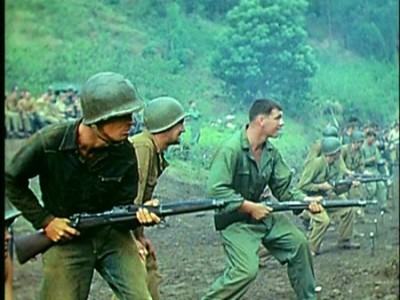
I'm not sure why Koch would re-title this doc (unless they thought the all-encompassing "Europe" title might attract more sales), particularly when anyone who buys it will certainly notice that the emphasis is obviously on France, its pre-war days, her role during the WWII conflict, and the liberation of Paris. As it stands, though, it's an amazing document of what France really looked like during the most horrific event of the 20th century.
And by "really looked like," I'm referring to a central theme that director Bouyer brings up early in Victory in Europe which posits a fascinating dilemma for the viewer. As the viewer marvels at the relatively unfamiliar sights of seeing everyday 1930s-1940s France in surprisingly good, lifelike color, Bouyer's statement that "color seduces and disorients us simultaneously" is an excellent point. On the one hand, we're taken with the more realistic depiction of the filmed image; the people and their surroundings looks more "modern," for lack of a better word, more "lifelike," and therefore more immediate because of the color. But on the other hand, the color footage is curiously disorienting, because WWII will forever be viewed by most of us as that "black & white war," because of the overwhelming use of b&w film stock to cover it (even when it was fictionalized by Hollywood). As Bouyer correctly states, newly developed Kodak Kodachrome was a precious rarity in America, let alone war-ravaged Europe, so its availability was scarce. Seeing these images, then, takes some getting used to because we're so locked in and oriented towards perceiving "World War II" as a b&w universe. These images seem strange and foreign to our collective perception of that conflict, which almost all of us have experienced through filmed b&w footage.
Indeed, the narration (written as well by Bouyer) states that, although the film focuses exclusively on newly found color stock, which may indeed leave out historical passages and people important to telling the whole story of France at war, the color stock gives us an "emotion, a presence denied to us from black and white." And I must say he's right. I've probably seen hundreds of documentaries on WWII, with almost all of them using b&w newsreel footage, and yet these color films - very little of which contain actual battle footage - have a tremendous impact. Viewed just on a perception-versus-historical reality level, Victory in Europe is a fascinating experience for those viewers who have become so accustomed to viewing these kinds of documentaries in their conventional formats.
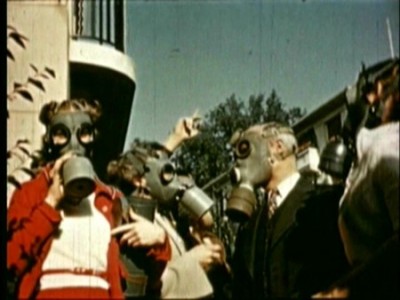
In Victory in Europe, Bouyer also brings out an intriguing subtext concerning the actual filming of these events. While the narration mentions some of the pre-war color footage, such as images of French President Albert Lebrun at the Orleans Joan of Arc festival, were recently found stowed away in an attic, that kind of "treasures in the attic" find pales when you consider Bouyer relating the fact that all the footage shot by German soldiers, whether on the battlefield or in the streets of Paris and French towns, were acts of espionage. According to Bouyer, the filming of anything by a German soldier was strictly forbidden by the Nazis, and punishable by death if found out. So the idea that these amateur filmmakers would flout orders to record these incredible images (most of the color stock was unavailable to French citizens) is incredibly ironic when you realize we have the enemy to thank for these incredibly precious images of France - a conquered, defeated France.
Victory in Europe, however, isn't just a collection of random color footage, gathered together for the sole purpose of wowing the viewer. Bouyer aims to tell the story of WWII France and how it failed to recognize the threat of Nazi German early, and how it paid for that conscious denial. Correctly identifying the decadence of the pre-war bourgeois democracy that had lost faith in itself on both the Right and Left side, coupled with an over-dependence on technically Europe's biggest (yet woefully outdated) military, France's perfect storm of willful blindness, both on the part of the government and its people, would have devastating effects for itself and indeed the world. The later footage of the resistance movement battling through the streets of Paris, as the populace makes tentative steps to re-imagine a world without constant terror and unending slaughter, is even more poignant (and senseless) when seen in context after the opening delineation of pre-war, Germany-appeasing France.
Not all of Victory in Europe focuses strictly on France, though. There are some incredible sequences of life in WWII America (including some rare footage of the earliest WWII G.I. recruits training in Virginia), while the U.S. government-sponsored footage of the war (entrusted to enlistee Hollywood elites such as George Stevens and John Sturges) are remarkable for their immediacy and verve - as well as their subtly "framed" reference points. Not everything works in Victory in Europe. I could have done without the gratuitous slap at America concerning the Saint-Lo bombing (which seemed a cherry-picked moment used for current political point-making), as well as the film's contention that American movie stars such as Jimmy Stewart and Clark Gable, who briefly shows up here, were over in Europe making "promotional films" (both, in fact, were decorated flight officers who flew combat missions over Europe). Still, when one weighs these missteps in comparison to the astounding color footage of gay Montparnasse night life prior to capitulation, the grotesque pageantry of various Nazi rallies, the busy streets of early1940s London, a tank battle between Panzer Tigers and U.S. Shermans, the mass graves discovered in Nazi-occupied countries, and the horrors of Dachau, they're minor drawbacks.
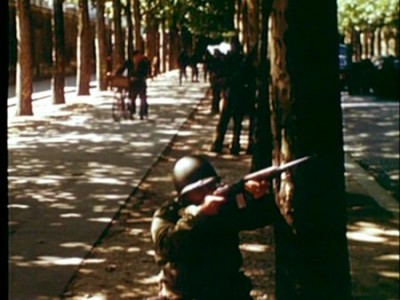
THE PACIFIC WAR
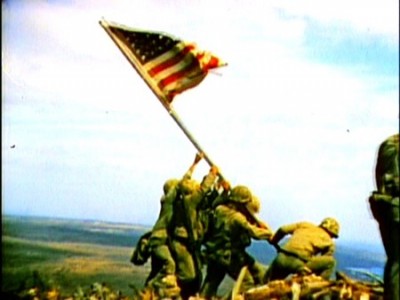
The Pacific War, fairly or not, seems less unique strictly in terms of its use of color film because so much of the battleground footage looks eerily similar to film shot during the Vietnam War. The site of G.I.s, unshaven and stripped down, enduring the hellish conditions in the unforgiving Asian jungles, almost disorient the average viewer if the differences in uniforms and arms wasn't readily apparent. This isn't to say that the use of color film in The Pacific War isn't impressive, but consistently, WWII documentaries have slighted the Pacific theater of operations in WWII to concentrate on the European campaigns, so footage of naval battles and jungle fighting during this time are less prevalent. The backlog of filmic impressions we have of that kind of fighting, in that kind of environment, seems to come more from later Vietnam documentaries.
That being said, The Pacific War is a far more focused, unified look at the incredibly brutal fighting that went on in the Pacific, than the more impressionistic Victory in Europe. Moving linearly through various major engagements of the Pacific war, this documentary contains quite a bit more battle footage than the previous doc, and will perhaps seem more familiar (in form) than Victory in Europe. Still, Bouyer brings out some intriguing, complicated discussions of what happened during this particular campaign, issues that quite a few other docs on the subject frequently skirt. In 1943, FDR lifted the ban on the American media that wouldn't allow gruesome pictures of dead American soldiers, killed in combat, to be shown. According to the film, it was an act undertaken to jolt the homefront American public, then slipping into complacency (and complaining) about the war, back to a sense of urgency and self-sacrifice to aid the war effort. You won't see too many WWII documentaries on The History Channel that acknowledge such feelings on the American homefront at the time.
Moving on to discuss the various causes of the Japanese escalation of violence in pre-Pearl Harbor days, The Pacific War is quite successful at analyzing the various cultural and political motivations in Japan that meshed to create such a storm of death and destruction. Japan's invasion of China, the horrible atrocities committed in Shanghai and Nanking (100,000 civilians - many of them woman and children - were massacred), are detailed, with the documentary flatly stating that the reasoning behind these and other actions were two-fold (and highly hypocritical): to rid Asia of the imperialistic white race, which was deemed decadent and inferior, while acquiring the raw materials of neighboring lands for tiny Japan.
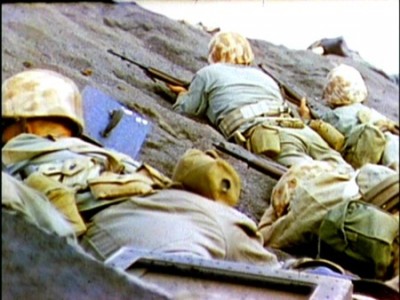
Spectacular footage of Dolittle's raid on Japan follows, along with footage of the Battle of Midway, shot by Hollywood director John Ford, serving in the armed forces as a documentarian. America's policy of interment for Japanese citizens and American of Japanese descent is covered, as well (along with the acknowledgment that espionage activity was occurring on the west coast), before extensive battle footage of the islands of the Pacific are included. The horrific battle of Tarawa, where for the first time Americans at home saw the true cost of war, is next highlighted, before we return back to the States to see the influence of women on the work force, as well as the poor treatment women doctors and nurses in the field received (Bouyer points out quite correctly the mixed feelings the American public had about women working back then - it wasn't all hurray for Rosie the Riveter).
Perhaps most interesting in The Pacific War is the discussion of the newly formed Public Affairs Office, which consisted of the very best ad men from famed Madison Avenue agencies, recruited to create for the American public the deliciously Orwellian term, "restricted reality." Charged by FDR with the job of mobilizing the rear guard without demoralizing them, the PAO's job was to film events of the war in such a way as to just shy away from completely freaking out the public - a difficult thing to do considering the tremendously difficult fighting that was occurring in the Pacific. The Battle for Saipan follows (with shattering, actual footage of Japanese civilians leaping to their death, rather than face their American captors - after having been brainwashed by their Japanese leaders into thinking the G.I.s would rape, torture and kill them), and then Iwo Jima, with amazing footage of G.I.s storming the beachhead and trying to gain a foothold on Mt. Suribachi. Here, Bouyer is quite adept at conveying the utter cultural confusion that the American soldiers felt, brought up on Judeo-Christian beliefs of suicide as a sin, when encountering the fanatical bushido code that the film states fueled a "holy war" where suicide was a virtue, not a shameful act of self-negation. This aspect of WWII as a Japanese "holy war," with militaristic Japan having fundamental problems with the West's "decadence" as well as their racial and cultural disdain for their enemy, is rarely discussed or alluded to in most western documentaries on the subject (and if it is, it's almost always referenced strictly from the standpoint of only the West being racist towards Japan).
The Pacific War winds up with footage of Burmese jungle fighting, harrowing footage of the U.S.S. Franklin nearly being sunk, amazing footage of B-24 Liberators coming off Henry Ford's Willow Run factory at the rate of one an hour, the terrible fighting on Okinawa and the fanatical kamikaze raids on U.S. naval ships. Morale sinks after these attacks (coupled with the death of FDR), but the war soon draws to a close with the dropping of atomic bombs on Hiroshima and Nagasaki. The Pacific War is appropriately grim in its delineation of the Pacific theater of war during WWII, a subject that always seems to get secondary treatment in most documentaries.
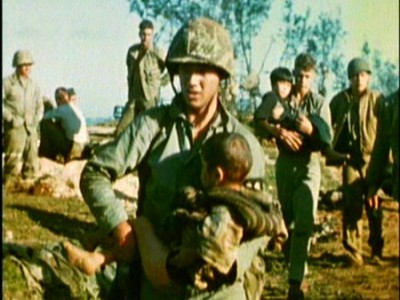
The DVD:
The Video:
The full-frame, 1.33:1 video transfers for They Filmed the War in Color: Victory in Europe and The Pacific War are about what you'd expect for found footage from over sixty years ago. With source material coming largely from 16mm (and even 8mm) prints, heavy scratches and dirt do crop up. But overall, the color footage is still impressive, and looks quite good here with no compression issues I could spot.
The Audio:
The Dolby Digital English mono track is relatively crisp, with all dialogue heard correctly (except for one brief moment in The Pacific War, at the very beginning of the film, were a couple of sentences are fast-forwarded). Close-captioning is not available.
The Extras:
There are no extras for They Filmed the War in Color: Victory in Europe and The Pacific War.
Final Thoughts:
It takes a lot to impress viewers who have seen years and years worth of war documentaries first on PBS, and then later with 24 hour coverage on cable networks like The History Channel and A&E. So, They Filmed the War in Color: Victory in Europe and The Pacific War is to be commended not only for its stunning compilation of ultra-rare color footage of both civilian and military life during WWII, but for its surprisingly in-depth, thoughtful analysis of the greatest conflict of the 20th century. I highly recommend They Filmed the War in Color: Victory in Europe and The Pacific War.
Paul Mavis is an internationally published film and television historian, a member of the Online Film Critics Society, and the author of The Espionage Filmography.


|
| Popular Reviews |
| Sponsored Links |
|
|
| Sponsored Links |
|
|
| Release List | Reviews | Shop | Newsletter | Forum | DVD Giveaways | Blu-Ray | Advertise |
|
Copyright 2024 DVDTalk.com All Rights Reserved. Legal Info, Privacy Policy, Terms of Use,
Manage Preferences,
Your Privacy Choices | |||||||















